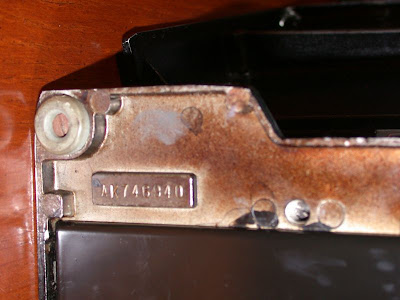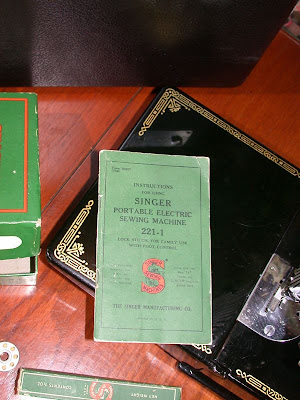••• SOLD •••
Vintage Singer 221 Sewing Machine
Very Clean - Serviced
Circa 1952
Made In USA
$649.00
Here is a little Singer 221 Featherweight that I refurbished in 2012. It had been owned by an elderly woman and sold by a family friend who knew nothing of sewing machines. He told me that it had the bobbin case, but what he meant was that it had bobbins. Always be sure that this particular model has the bobbin case. An original vintage bobbin case will run about $50 if you can find one. Lesson learned. It had the accessories foot pedal, case with keys, and the manual. I was able to find and add the grease and unopened vintage needles.
The unit was dirty and needed grease and lube. The cords and belt were good, but the bobbin tire and spool felts needed replacing. It shined up beautifully and ran like a dream.
The thing that is peculiar about the Featherweights is that the case and machine reek of a 1,000 moldy basements. It is hard to describe just how foul these things can smell. We had to keep it in the garage until determining how to deodorize it. It all has something to do with the glues used to assemble the case, the vintage oils that collect on the drip pan felt becoming rancid, and where the thing was stored over the past 50-60 years. Mine stunk to high heaven.
There is a plethora of home remedies for eradicating the odor on the internet. We first tried ZORBX which did nothing; don't waste your money. We then placed a plate full of ground coffee beans in the closed case for a week... then it smelled like musty coffee. I sprayed it with Lysol which helped a little, but the smell came back. Finally, I placed the closed case in my closed truck in the heat of a North Carolina summer for about a week. Odor definitely better. With the case now opened, it spent another hot week in the back seat of the truck. I finished off the treatment by misting lavender oil on all of the interior surfaces of the case... several applications. The case finally smelled like my grandma's potpourri laced dresser drawers.
The machine also stunk... even after cleaning, polishing, and waxing. These were one of the first machines with an oil drip tray built into the case. There is a felt pad which lies on the tray to absorb any oil. I suppose this was intended to keep young ladies attire from becoming sullied as they carried the machine from place to place. Unfortunately, it also created a repository for the oil to accumulate and soar to never before recorded levels of rank rancidity. I found replacement pads at www.sew-classic.com . Jenny, who owns the site, has many, many replacement parts for vintage Singers and many other makes of old machines. After cleaning the tray and replacing the pad, I left the machine in the lavender sprayed, closed case for another month; applying repeat treatments of the lavender oil every couple of days. This hid but did not eliminate the stink. I then loaded it with ground coffee and let it sit in the hot garage... no joy. I tried all of the potions at the box store... no luck. I even sprayed on some hydrogen peroxide with little result. The last thing that I tried was to leave it in the back of my closed truck for a month in the mid-summer heat. THIS WORKED...!!! Finally the stench was gone and we could bring the machine into what has become the sewing machine display and rescue room... i.e., the dining room.
So now the machine, case, and accessories comprise what might have been a typical original purchase package. I like things being complete, clean, and in working order.
I intended all along to sell this machine once I got it working and looking good, but the more I looked at it, the more I fell in love with the design, the light weight, and the quality of the mechanical engineering and machining that went into its manufacture... plus it was just darned cute.
Finally, I wanted to get this machine into someone's hands who might use it... and so it was sold. I think I miss the oil can as much as the machine.
I learned a lot from the 221 and used the money to purchase a Necchi BU Nova.
I hope you enjoy the photos.
Michael
SOLD December 2012





















What a beautiful machine -- however did you manage to part with it? I just "rescued" a circa 1950-1951 (based on serial number) Featherweight that looks just like yours, except that it has the scrolled faceplate rather than the striated. I am currently enjoying the rank stench of mold and rancid oil that you described! The case is so foul that it's out in the garage for the time being. But the stinky machine is on my kitchen counter.
ReplyDeleteA couple of questions: First, is it possible to clean and polish the machine's exterior without disassembly? I removed the faceplate to polish and clean off the tarnishing, but I have tarnish and grime in other places that should be shiny, like the bobbin winder thingy and the chrome parts of the needle tension assembly. Do I need to take that completely apart to clean it properly? I don't want to get the tarnish remover on any of the machine's black painted areas. Also, my machine has a cloudy and dull finish. The little scratches and tiny chips here and there I can deal with, but I would like it to be shiny again -- and I want to protect the gold decals, which only show some wear at the front and back edge in line with the presser foot, where fabric has passed through the machine for many years. Any suggestions would be greatly appreciated. Thank you!
Hi Rebecca... thanks for the very kind words.
ReplyDeleteYes, it was very difficult to part with my 221. I didn't expect it to be so "cute". I kept it for months before I finally decided to sell. I wasn't using it after I got my 15-91. The 15-91 is a full size machine whose power is more suited to the sewing that I do. I don't travel with my machines and I don't quilt. I tend to do assembly up to eight thicknesses. It just seemed a waste to keep it in the closet. I used the money to purchase a Necchi BU Nova in a beautiful mahogany cabinet with a knee control... love the knee control.
You do not have to disassemble to clean and polish the machine. Take off what you can. I did remove the motor to get the grunge underneath and give it a fresh coat of wax under there. I used McGuires swirl and scratch remover to clean the entire machine. It has a light abrasive and cleaner that cuts right through the grime. I went easy and it didn't damage any of the decals. Around plates, grooves, and edges, I used a fine toothbrush to get into the crannies. Don't use any alcohol on the finish! I couldn't believe the shine that came through, both on the paint and the chrome, after using the McGuires. I then finished it off with Mother's pure canauba paste wax. I did use metal polish on the face plate and tension device. I took the entire tension assembly apart to clean and polish every part. I then used a greaseless lube by Dupont. It won't attract lint and dust.
On the inside, I used a rubber paint brush (kind of like a mini spatula, to dig the grease off of the gears and tons of q-tips to clean all of the old oil off the interior surfaces. Use Tri-Flow oil to lube ALL moving parts and Tri-Flow grease to lube the gears.
Be sure to inspect your wiring and replace any with brittle or damaged insulation. You can get a new bobbin winder tire at sew-classic.com. They have the drip felt that goes on the bottom plate. You must replace the felt and clean the tray completely to have any hope of getting rid of the stench. Follow my write-up on the stink removal process above. It did work.
Good luck and thanks for your comment!!!